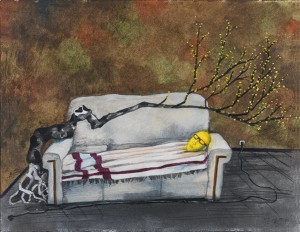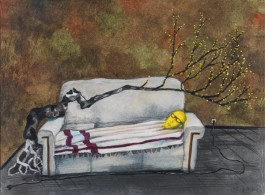Zhang Xiaogang’s Oil on Paper-Pace Hong Kong’s Inaugural Show

The Prisoner of Book No.5 書囚5號 2014 oil on paper 紙上油畫 30 x 39.5 cm
Opening Reception: 13 May 2014, 6pm – 8pm
Exhibition duration: 2014.05.14- 2014.07.12
Location: 15C Entertainment Building, 30 Queens Road Central, Hong Kong.
We are pleased to announce that Pace Gallery is now launching in Hong Kong with a new office, bringing one of the most famous Chinese contemporary artist Zhang Xiaogang’s latest oil on paper works to constitute its inaugural show.
The paintings of Zhang Xiaogang stem from his individual experience and memory. He utilizes narrative scenes to express his own personal history, story and emotional sensibility. His point of origin draws from the dialectic between history and reality, culture and society, collective memory and personal recollections, respectively, to advance his compositional aesthetic. Furthermore, on the surface of the canvas, Zhang blends the character of lyricality with surreality, imbuing the history of a generation of Chinese people with a wide applicability, while at the same time also assigning his own new vitality. Zhang Xiaogang was one of the foremost contemporary Asian artists to achieve recognition and familiarity overseas.
As early as the 1995 46th Venice Biennale, Zhang Xiaogang has exhibited his series of milestone significance, Bloodline: Big Family. This series involves monumental characteristics, using the commonplace old Chinese household picture to serve as the blue print. The center characters usually sport the imprint of the archetypical Mao Zedong era with their clothing; their bodies possessing birthmarks that have transmuted into scars. Furthermore, the slim red bloodlines that link them together reveal the blood relation between family members. Zhang Xiaogang treats memory as a course of events being unceasingly amended. In creating his later series, probing into remembrance, writing, private emotions and public narrative became the continuous theme. In another series regarding the classics, Green Wall, introduced green oil paint on the surrounding wall, which is a common symbol from a special period in Chinese history. The piece involved the human figure and a tacit object. The scene became one. Once again, Zhang delves into the difference between public and private space, slyly manipulating the place betwixt individual experience and private memory. In his newest creative works in oil paint, by means of once again observing carefully and realizing the intimate relations between family members, Zhang takes the complexity and concretization from the bloodline theme to form the main character’s mutual and interweaving vision, as well as each family member’s individual psychological projection and ego cognition that accompanies their familial role. Furthermore, he employs exquisite composition and atmosphere to build all kinds of boundless language micro-pulsing on the surface of the canvas. The end creation brings about the ideal, the fantastic, mental associations and desire interwoven together in a new multi-faceted dimension.
Zhang Xiaogang is an artist that unceasingly breaks through the concept of ego. From his early period he drew from the essence of German expressionism and Surrealism, utilizing rich religious and philosophical ideas and emphasizing the spiritual property of painting. From 1993 onwards, he began to exhibit his well-known Bloodline series, further stressing his human modular statement. Until 2010, Zhang began to produce two-dimensional drawings that transformed into three-dimensional sculptures. He used rustproof steel to act as the canvas surface involving the characteristics of bas-relief to achieve media synthesis. At the same time, he wrote in the Chinese traditional art style the most typical symbol to draw into the artwork into the present moment. Zhang combined silkscreen printing with the mastery of his own calligraphic skill. In his own artistic process, Zhang employed a tremendous amount of thinking and perception in the way in which he wrote the characters on canvas. This exercise proved to have an ulterior function, giving his painting’s modular silent objects and human characters a three-dimensional sculptural quality. Together, this amalgamated in the artist’s 2013 creative series of bronze casting sculptures in New York that received wide acclaim. In Pace Hong Kong’s inaugural exhibition, the artist used the formality of oil painting on paper, integrating the Western notion of Surrealism with the Eastern conception of classical art. The work is full of imagination and mystery, his subtle artistry on paper reflecting the zenith of skill.
About Pace Hong Kong
Pace is a leading contemporary art gallery representing many of the most significant international artists and estates of the 20th and 21st centuries. Founded by Arne Glimcher in Boston in 1960, Pace has been a constant, vital force in the art world and has introduced many renowned artists’ work to the public for the first time. Pace has also published nearly 350 exhibition catalogues and mounted more than 700 exhibitions, including scholarly exhibitions that have subsequently travelled to museums. Today Pace has seven locations worldwide: four in New York; two in London; and a gallery in Beijing, also two exhibition spaces located individual at Zuoz in Switzerland and Hong Kong. In May of 2014, Pace Hong Kong, which is directly administrated by Pace’s Asian Regional Partner Leng Lin, announced plans for its new space located in Central of Hong Kong in the Entertainment Building. Pace Hong Kong is open to the public, Tuesday through Saturday, 11 a.m. to 7 p.m.
Since 2008, The Pace Gallery has established itself in Beijing as a premiere branch of the organization, steadily advancing as the Asian market continues to develop. The gallery spared no pain or effort promoting a blend between contemporary Asian and Western artists. At the same time, the gallery also promoted the booming contemporary Asian art realm in its cultural role. Commencing in 2010 as a permanent yearly exhibition, Beijing Voices reflects on the metropolitan territory’s art phenomenon and issues from the previous year. Pace Beijing continues to be an extensive pioneer and influential player in Asia. This year, the Pace Gallery officially expanded into Hong Kong, harnessing Zhang Xiaogang’s latest artwork to serve as its inaugural exhibition, further proclaiming the intentions of the Pace Gallery in terms of its Asian strategy and vision.
About Artist – Zhang Xiaogang
Zhang Xiaogang was born in 1958 in Kunming, the capital of Yunnan Province in Southern China. When the Cultural Revolution began in 1966, Zhang was eight years old. At the age of 18, Zhang was sent to the “re-education camp” to labor alongside peasants. Following the collapse of the Cultural Revolution, the Sichuan Institute of Fine Arts in Chongqing accepted Zhang Xiaogang in 1997. He graduated with a B.A. degree in Oil Painting in 1982. Zhang was subsequently appointed as a professor at Sichuan Institute of Fine Arts. The artist current lives and works in Beijing, China.
Since 1989, Zhang has had 19 solo exhibitions and has participated in nearly 150 group exhibitions. His major exhibitions include Zhang Xiaogang at Pace, New York (2013), Zhang Xiaogang: Shadows in the Soul at Queensland Art Gallery, Brisbane (2009), Revision at PaceWildenstein, New York (2008) and Zhang Xiaogang at Sara Hilden Art Museum, Tampere, Finland (2007). His work can be found in numerous private and public collections worldwide.



